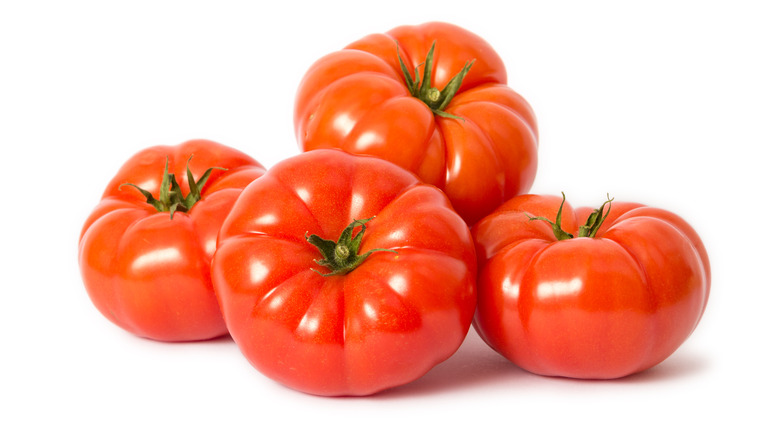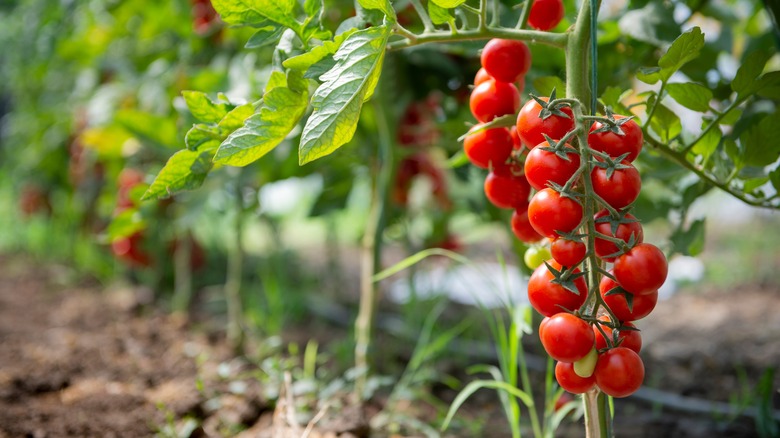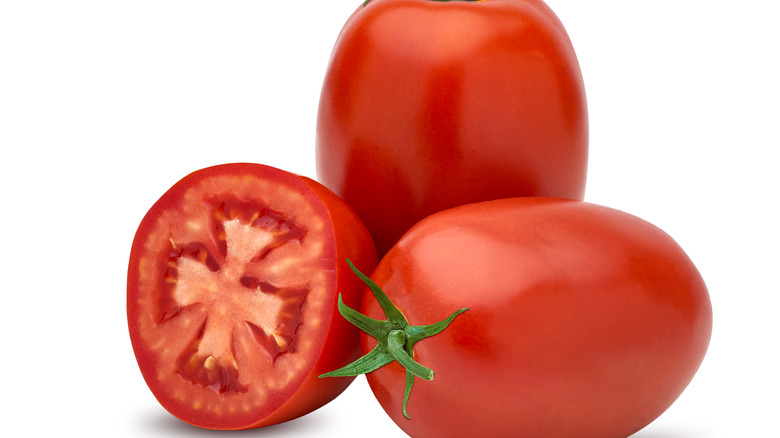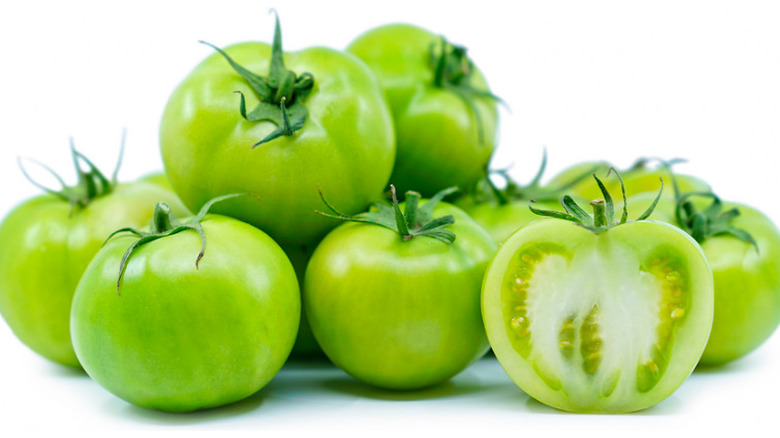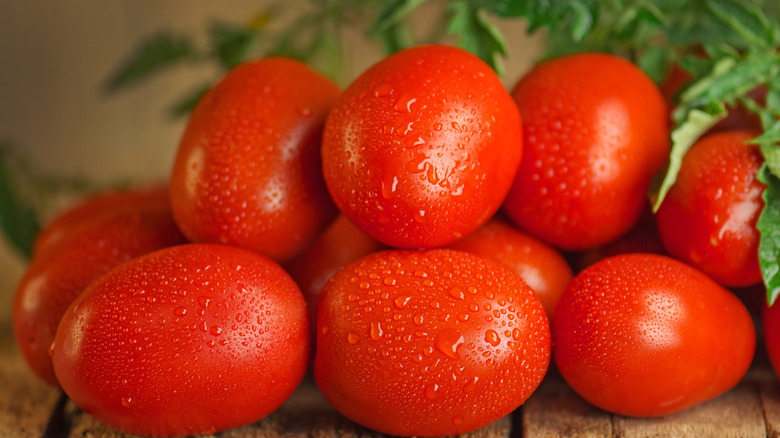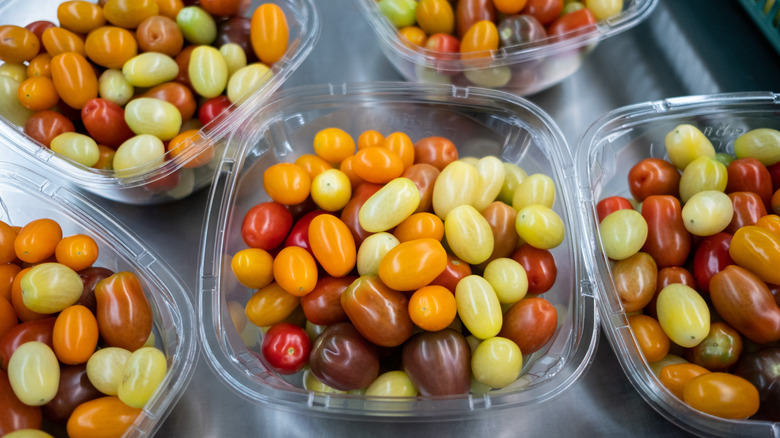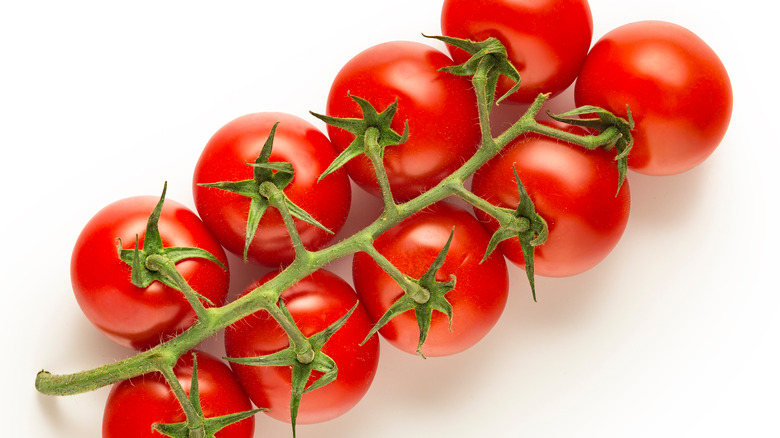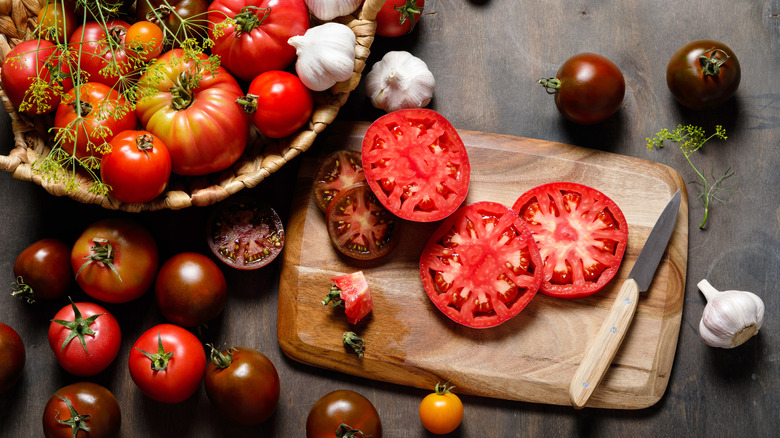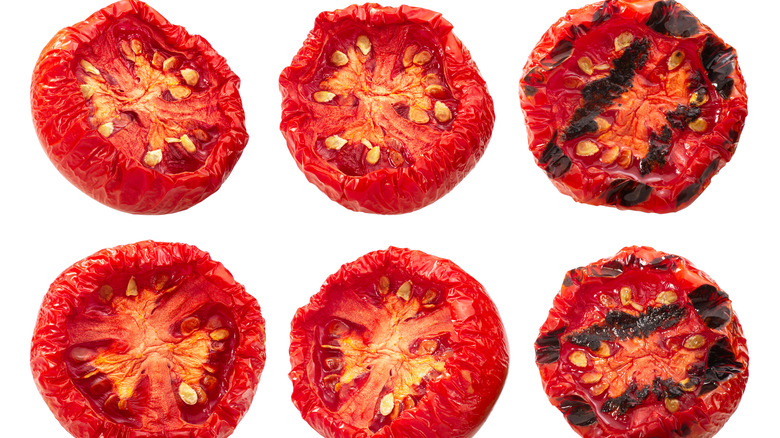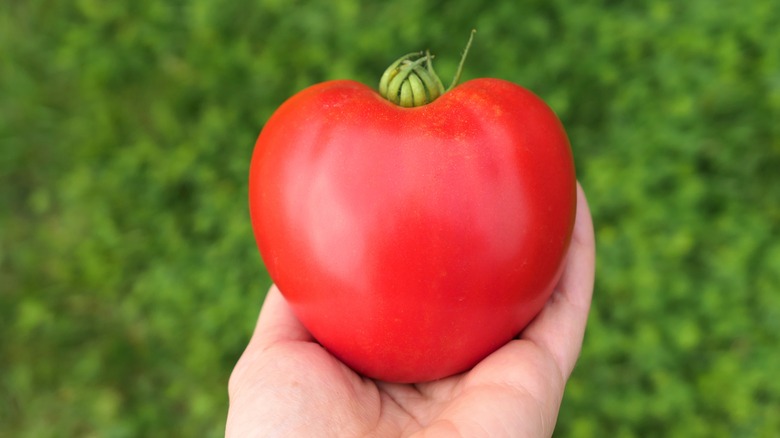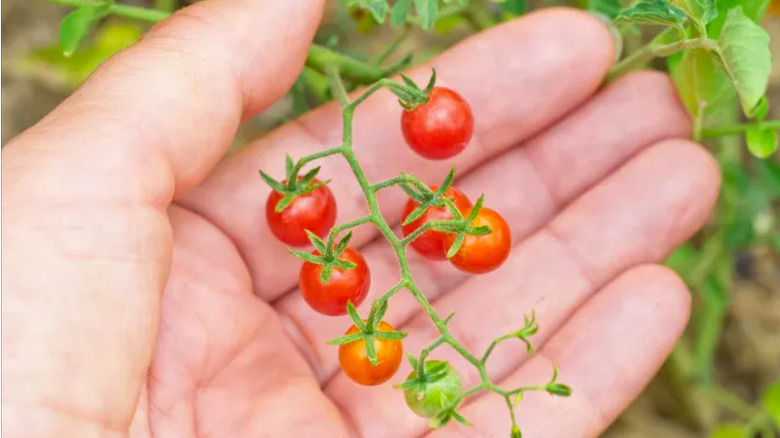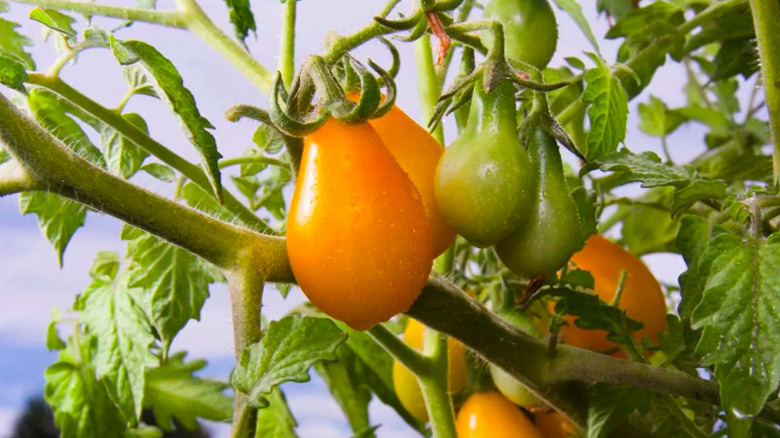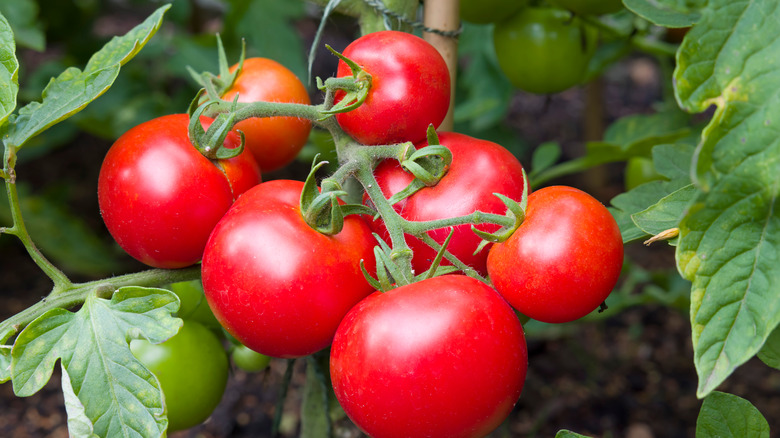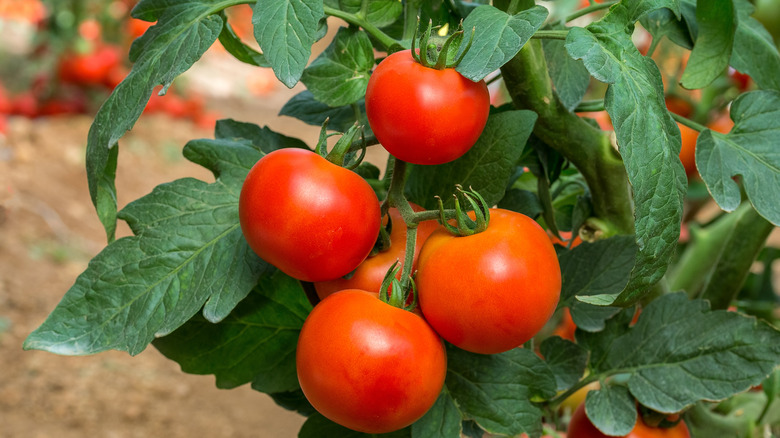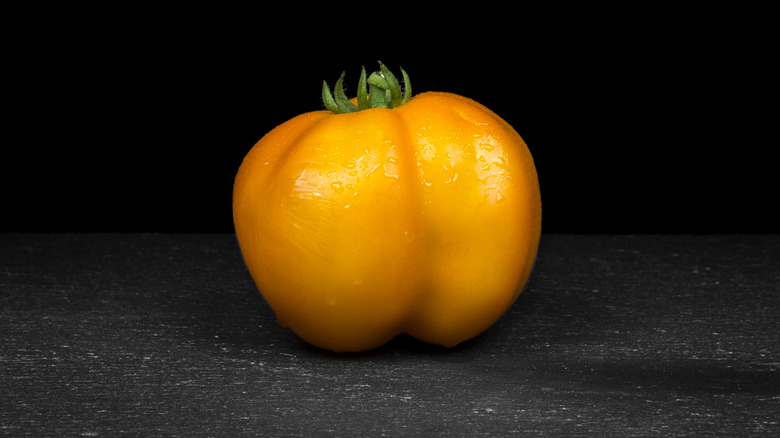Know Your Tomatoes: A Guide To The Top 15 Types Of Tomatoes
We may receive a commission on purchases made from links.
Tomatoes are a popular fruit in home gardens and kitchens worldwide. The pungent, fresh-from-the-ground smell and soft juicy flesh make tomatoes a popular ingredient for sauces, salads, vegetable platters, sandwiches, and even snacking right off the vine. But did you know that there are over 10,000 varieties of tomatoes on the planet in almost every color, according to Homestratosphere?
Tomatoes are selectively bred for different purposes, including color, taste, size, and appearance. There are some things that all tomatoes have in common: 1) a shared ancestry that dates back to the Aztecs, and 2) they're all members of the nightshade family.
Each variety of tomato has numerous tangible physical and taste qualities that make the fruit unique and suited for distinct purposes. This guide is an introduction to the most common types of tomatoes you can find in a garden or grocery store, as well as how best to use each variety in the kitchen.
Beefsteak tomatoes
Minneopa Orchards notes that the beefsteak tomato is easily distinguishable for its size (which can grow up to four pounds), flat shape, and meaty texture. Beefsteaks represent a diversity of colors including reds, pinks, and oranges. Sub-varieties of beefsteaks include Cherokee Purples, Black Krims, Bucking Broncos, and Mortgage Lifters (we're not kidding).
Beefsteaks have a very meaty flesh and classic tomato flavor. This type of tomato is a classic component of the bacon, lettuce, and tomato (BLT) sandwich as well as gemista (Greek stuffed tomatoes). The skin on a beefsteak is sturdy when roasted but will easily peel under pressure. This makes the beefsteak a good choice for baking and roasting under high heat. It is also a juicy type of tomato, so it works well for recipes that require a lot of liquid. You may also see beefsteaks used for tomato juice — but chefs tend to use a juicier heirloom variety with a less attractive exterior for juicing (like a Brandywine), according to SF Gate.
Cherry tomatoes
Cherry tomatoes are named for their small shape and resemblance to another popular summer fruit. Masterclass notes that although red is the most common color for these tiny tomatoes, black, yellow, and green varieties are also grown. Unlike grape tomatoes, cherry tomatoes are rounder and have higher water content. These factors, as well as its thin skin, make cherry tomatoes distinct from other varieties.
Cherry tomatoes are sweet — just like the fruit's namesake. This makes the cherry tomato an ideal option for salads like a cherry tomato caprese with fresh mozzarella balls, basil leaves, halved cherry tomatoes, and balsamic vinegar. Chef Jeff Mahin recommends using roasted cherry tomatoes for charred tomato oil. This oil is infused with the pungent flavors of cherry tomatoes, some salty umami from cured anchovies, and a punch of fresh garlic. Drizzle the vinaigrette on peppery greens, pizza, or a grilled steak for a hit of sweet tomato flavor.
Plum tomatoes
Plum tomatoes, also known as Italian-style tomatoes, are firm, red, and oval. It is rare to see a plum tomato in a fresh salad because it is usually reserved for sauce. The plum variety was selectively bred for canning, and they're known for their chewy bite, firm flesh, low moisture, and low acidity, according to the Gardening Channel. Subvarieties of plum tomatoes include the San Marzano tomato and grape tomato. You might also hear plum tomatoes colloquially called Italian tomatoes, paste tomatoes, sauce tomatoes, or saladette tomatoes.
Outside of sauces, plum tomatoes can be used for dishes that need the textural element of tomato without imparting too much of its flavor. Chef Chris Shepherd's red-wine braised lamb neck is just one recipe where tomatoes provide a fresh lift of flavor without disrupting the complex flavors of lamb, red wine, shallots, and vegetables. The recipe also uses tomato paste to heighten the umami flavor.
Green tomatoes
Yes, green tomatoes are commonly known as the main ingredient in fried green tomatoes, but did you know there's more to these fruits than just deep frying? There are two types of green tomatoes according to Farm Flavor: ones that are unripe red tomatoes and ones that will stay green throughout their entire fruiting cycle (which are typically heirloom varieties). The green tomatoes you find on restaurant menus are typically the former.
Green tomatoes are harvested intentionally before ripening or are fruits that did not end up ripening by the end of the growing season. Green tomatoes have less juice than red tomatoes and impart a tart, acidic flavor. Although green tomatoes will inevitably soften when exposed to heat, these fruits are much more tolerant to high-heat cooking than red tomatoes (per Farm Flavor).
Besides fried green tomatoes, you can use green tomatoes for pickling. It's a great way to use the unripened tomatoes before the first frost hits! Masterclass recommends a one-to-one vinegar to water ratio for the pickling brine, along with one tablespoon of sugar and two teaspoons of salt for each cup of vinegar used. After two days of fermentation, the pickled tomatoes should be ready to eat.
Roma tomatoes
According to the Pennsylvania Vegetable Marketing & Research Program, the Roma (or Italian plum tomato) is a type of plum tomato that is frequently found in grocery stores around the world. Like other plum tomatoes, the Roma has a thick wall and fewer seeds to contend with. Gardening Know How describes its flesh as dense and grainy. These factors contribute to the Roma tomato's notable weight and oblong shape. You'll find that these tomatoes have a relatively mild tomato flavor with balanced acid notes.
Chef Giada De Laurentis recommends slicing Roma tomatoes into ¼-inch slices for a fresh tomato pizza. If you're looking for a little fresher recipe, you might try roasting halved, de-seeded Romas. Crumbled feta, earthy extra-virgin olive oil, and chopped fresh herbs elevate the relatively bland flavors of the Roma. Plus, this recipe can be grilled or baked and ready in less than 20 minutes!
Grape tomatoes
Grape tomatoes are another appropriately named tomato variety. Southern Living notes that grape tomatoes have a thicker, chewier, and meatier texture than cherry tomatoes. The tomato's shape also resembles more of an oblong grape than a round cherry tomato and comes in a variety of yellow and orange hues (although the most common color is red).
The tiny size of the grape tomato makes it a great companion for fresh salads or snacking. The firm skin of the grape tomato also makes it a good candidate for roasting. For a mix of sweet and savory profiles, InFoodMarketing recommends pairing honey-roasted grape tomatoes with fresh ricotta and broiling the two over baguette slices. This bruschetta is divine and perfectly accented with chopped basil. Tasty Thrifty Timely uses grape tomatoes for a five-minute salsa made in a food processor. The tomato's thick skin adds texture to this salsa along with the boost of flavor from jalapeños and cilantro.
Cocktail tomatoes
Cocktail tomatoes are a relatively small variety with a powerful, sweet bite. They are typically sold on the vine and come only in red, according to The Produce Market Guide. The symmetrical appearance of the cocktail tomato makes it a common sight on charcuterie boards. Nature Fresh Farms suggests chopping cocktail tomatoes with red onion, diced garlic, thyme springs, and rosemary for a summery side salad. Although the cocktail is not as juicy as other varieties, its sweet flavor meshes with savory Italian spices.
While there is a lot of beauty in leaving the cocktail tomato raw, many chefs choose to cook it. Pure Flavor recommends cooking roughly chopped cocktail tomatoes with fresh garlic, herbs, olive oil, and spices for a tomato sauce. For a summery flair, LoveMySalad recommends grilling skewered cocktail tomatoes with onion, mushrooms, peppers, and halloumi cheese. The golf ball size of the cocktail tomato also makes the appetizer perfect for a one-bite snack at a barbecue.
Heirloom tomatoes
Heirloom tomatoes are grown from seeds passed down from generations of growers. Non-commercial heirloom varieties are also open-pollinated, meaning that the variety may be crossed with other types of tomatoes that encounter pollinators (like bees and butterflies). These tomatoes come in a beautiful array of colors and patterns, and the color and flavor of the tomato will depend on the climate it's grown in as well as its phenology (the physical expression of genetic traits).
Heirlooms are very attractive, flavorful, and useful tomatoes for serving. Heirloom tomato and ricotta tart is one way to artistically display a variety of heirloom tomatoes. The recipe also recommends using a few heirloom cherry tomatoes to break up the design. The freshness of these beautiful fruits is also complemented in Susan Olayinka's heirloom tomato panzanella. These chopped tomatoes soak into baked ciabatta cubes and complement fresh cucumbers, dill, shallot, and basil. You'll preserve the color and texture of the heirloom tomatoes by leaving them raw in a recipe, but they can also be cooked into sauces.
Globe tomatoes
The globe tomato is described as plump, red, and juicy by Washington State University. Its name is derived from its round, globe-like shape. Varieties of globe tomatoes include the beefsteak, Early Girl, Super Bush, and Better Boy. Although there is some variation in shelf-life and texture across varieties of globe tomatoes, they are overall considered a flavorful and meaty type.
The standard globe tomato, according to Grow Garden Tomatoes, is often smooth and uniform in texture. Therefore, the globe tomato is commonly referred to as a "slicer tomato" due to its use in sandwiches, salads, and burgers. For a low-carb sandwich, try substituting sliced globe tomatoes for bread. Or take inspiration from José Andrés' beefsteak tomato sandwich made with pickled red onions, herby mayonnaise flavored with capers and Dijon mustard, avocados, and beefsteak (or globe) tomatoes. Andrés blanches the tomatoes for this recipe before removing the skin for a velvety, smooth bite.
Oxheart tomatoes
Oxheart tomatoes are distinguished by their shape per Bountiful Gardener. A genetic mutation in the tomato causes the bottom to elongate and since then, the tomatoes have been selectively bred for this unique trait. Oxhearts resemble the beefsteak's flavor and textural profile: meaty, heavy, and slightly sweet. Most oxhearts are red, but some varieties include green, purple, yellow, and pink colorations.
Oxhearts are fleshy and thus ideal for canning or stuffing. To preserve tomatoes in a jar, you'll want to blanch them before adding bottled lemon juice and salt. After boiling the cans and checking the seals, your persevered oxheart tomatoes will keep for about a year. This method is especially valuable for home gardeners to use; oxheart tomato plants are one of the most productive varieties in circulation. If you're still running out of ideas for your oxhearts, consider a chilled Mexican gazpacho soup with seeded oxheart tomatoes.
Currant tomatoes
According to agriculturalist Bonnie L. Grant (for GardeningKnowHow), currant tomatoes are significantly smaller than cherry tomatoes. Although red is a popular color, some varieties like the White Currant tomato can produce small yellow fruits. The Sweet Pea bears red fruits about ¼ the size of cherry tomatoes, per Premier Seeds Direct.
Each currant tomato plant will bear hundreds of small, sweet, oval fruits that are ideal for preserves and canning. The Full Helping uses cherry tomatoes for savory, chutney-like tomato jam — but in fact, substituting currant tomatoes for cherry tomatoes would be quite simple. You can add tomato jam to grain pilafs, roasted tofu, grilled chicken, hummus, or spread it on a slice of crusty bread. The best part about tomato jam is you can adapt the spices based on the desired flavor. For an Indian-inspired tomato jam, use cumin, coriander, and garam masala. For a Thai twist, try adding red curry paste and lime zest.
Pear tomatoes
Pear tomatoes are — you guessed it — shaped like pears. Like oxheart tomatoes, the pear tomato is the result of a genetic mutation in the plant that causes a bulbous base, per Gardener's Path. Each tomato is between an inch and two inches long. The yellow pear is the most popular variety of these quirky fruits, and it is known as a prolific producer.
The taste of the pear tomato has been described as mild and slightly tart, according to Gardner's Path. Preserves are one of the most popular uses for the yellow pear tomato variety due to their mild flavor; they can be combined with warm sweet spices like cinnamon and cloves. Midwest Living recommends pickling pear tomatoes with sweet onion, garlic, red pepper, colored peppercorns, salt, and balsamic vinegar. The result is a flavorful chunky dip that can be spooned onto a baguette, crackers, or eaten as-is.
Tomatoes on the vine
Some types of tomatoes are sold on the vine to extend their ripening time. Backyard Farms picks their on-the-vine tomatoes in clusters of four or five after growing for almost a year in a greenhouse. Once the tomatoes are picked, they are distributed to stores in cardboard or plastic packaging.
According to Nature's Sweet, tomatoes left to ripen on the vine have a stronger aroma and higher levels of antioxidants than tomatoes that ripened off the vine. The flavor profile of these tomatoes is sweet, juicy, and fresh. On-the-vine tomatoes should be left with stems intact until ready for use in the kitchen. While you can gently pull the tomatoes off the stem for sauces, salads, and canning, you can also leave the tomatoes on the vine for roasting. Nutmeg Nanny recommends adding a few pounds of on-the-vine tomatoes to a baking dish and seasoning with olive oil, salt, and pepper. After the tomatoes are well-seasoned, roast them for about 35 minutes at 350 F until the skin is soft and cracked. It is important to remember that larger tomato varieties take a longer time to roast than smaller varieties.
Early tomatoes
Early tomatoes ripen before other varieties. According to Harvest to Table, early tomato varieties have less flavor than regular-season tomatoes because the early-season varieties are not exposed to the same sunlight and growing conditions. This slows the production of sugar in the plant.
All varieties of tomatoes can be considered early-season if their fruit ripens between 55 and 70 days after being transplanted. Popular early-season varieties include the Gold Nugget (cherry tomato), Yellow Bell (paste tomato), Beefmaster (beefsteak tomato), and First Lady (globe tomato).
Early tomato varieties can be used in sauces, sandwiches, or snacks in the same way as their regular-season counterparts. To enhance the flavor profiles of early varieties, Nature Sweet recommends complementing less flavorful tomatoes with fresh herbs like basil, thyme, and chives. Salt is also a valuable balancing flavor in tomato dishes. It can be used as an alternative to baking soda and sugar in acidic tomato sauces as well.
Specialty tomatoes
The University of Nebraska-Lincoln Extension classifies a select few tomatoes as "specialty" varieties because of their distinct shapes and qualities. The Gourmet Yellow Stuffer, for example, is selectively bred for its pepper-like appearance. This lobed variety is used almost exclusively for stuffing because of its wide shape and concentrated seed cluster. According to Victory Seeds, each fruit weighs between four and eight ounces and ripens to a dark gold color.
The Burpees Long Keeper is a slicing tomato that was bred for its ability to stay fresh six to 12 weeks after picking. These tomatoes are excellent for slicing and retain their flavor over time. Use the Burpees Long Keeper for the same purposes as beefsteak or globe tomato — for slicing and sandwiches.
Another specialty variety is the Striped Cavern tomato. Like the Gourmet Yellow Stuffer, this colorful variety was bred as a grilling or stuffing tomato thanks to its thick walls and hollow interior. This flavorful tomato pairs well with soft cheeses, fresh parsley, and shallots.

